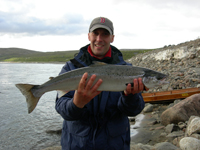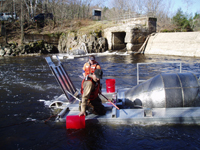Federal Agencies to Propose Expanding Gulf of Maine Atlantic Salmon Population Protected by Endangered Species Listing
September 2, 2008

Atlantic salmon.
High resolution (Credit: NOAA)
NOAA’s Fisheries Service and the U.S. Fish and Wildlife Service today announced a proposal to redefine the endangered Gulf of Maine population of Atlantic salmon to include fish found in other nearby areas.
The proposal would expand the endangered designation to consist of Atlantic salmon populations from the Androscoggin River to the Dennys River, including anadromous salmon inhabiting the Kennebec and Penobscot rivers, as well as hatchery fish used in the recovery effort. Currently, such hatchery populations are maintained at Green Lake and Craig Brook national fish hatcheries. Including fish from these populations, the 5-year average (2002-2007) number of spawning fish is nearly 1,200.
Atlantic salmon currently covered under the endangered listing include fish in rivers and streams in Maine from the lower Kennebec River north to the U.S.-Canada border. These include the Dennys, East Machias, Machias, Pleasant, Narraguagus, Ducktrap, and Sheepscot rivers and Cove Brook. Between 2002 and 2007, these populations averaged fewer than 100 spawning fish annually.

Researchers removing very young salmon bound for the Atlantic from water-powered traps in the Sheepscot River.
High resolution (Credit: NOAA)
The action is consistent with recommendations made public in a 2006 review of the status of Atlantic salmon in Maine. The agencies initially defined the Gulf of Maine population and listed it as endangered under the federal Endangered Species Act in 2000, but deferred inclusion of fish found in portions of the Penobscot and Kennebec rivers and their tributaries, pending additional study.
So far this year, roughly 2,000 adults from the proposed expanded endangered population have returned to spawn. This is a slight increase over recent years, but just 10 percent of the number required before spawning stocks are thought to be in good condition.
Species listed as endangered are offered the full protection of the Endangered Species Act, including a prohibition against take. Take is defined to include harass, harm, pursue, wound, kill, trap, capture, or collect.
Public hearing times and places will be announced shortly. Public comments on the proposal will be accepted by the Services through December 2, 2008. The agencies are particularly interested in comments on using hatchery fish to supplement wild populations as a way to reduce the risk of extinction, on viability and/or threats to Atlantic salmon in the Gulf of Maine population, and on current efforts to protect these fish.
A final rule is expected after the agencies have reviewed the public comments. For more on Gulf of Maine Atlantic salmon protection and recovery, visit us on the Web site.
NOAA understands and predicts changes in the Earth's environment, from the depths of the ocean to the surface of the sun, and conserves and manages our coastal and marine resources.
